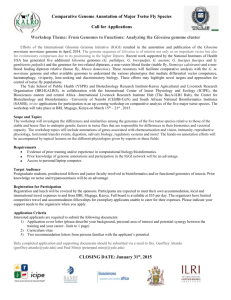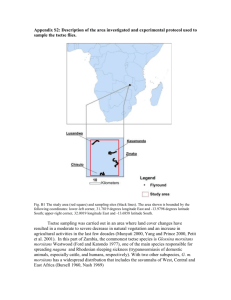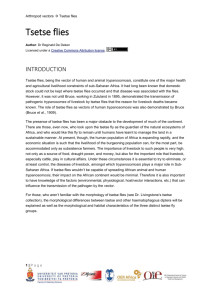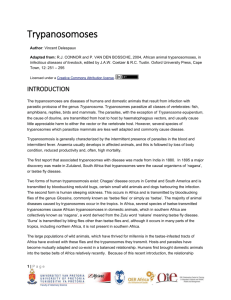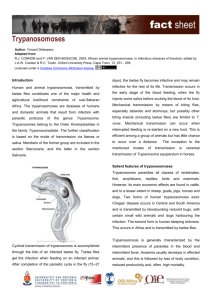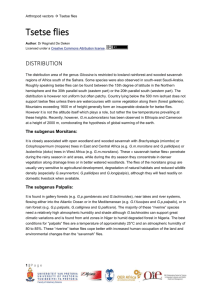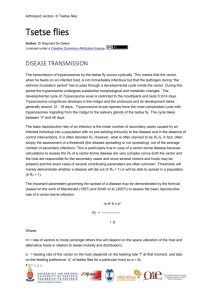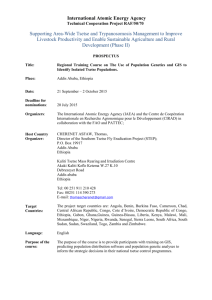Determinants of Human African Trypanosomiasis Elimination via Paratransgenesis Supporting Information Text S1
advertisement
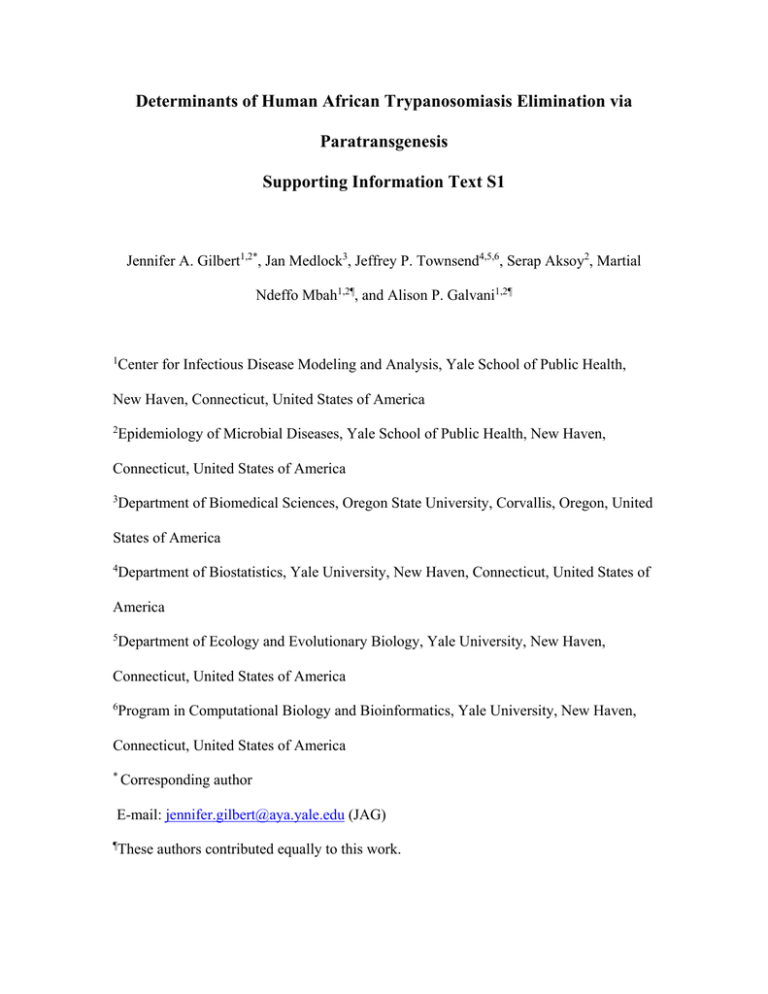
Determinants of Human African Trypanosomiasis Elimination via Paratransgenesis Supporting Information Text S1 Jennifer A. Gilbert1,2*, Jan Medlock3, Jeffrey P. Townsend4,5,6, Serap Aksoy2, Martial Ndeffo Mbah1,2¶, and Alison P. Galvani1,2¶ 1 Center for Infectious Disease Modeling and Analysis, Yale School of Public Health, New Haven, Connecticut, United States of America 2 Epidemiology of Microbial Diseases, Yale School of Public Health, New Haven, Connecticut, United States of America 3 Department of Biomedical Sciences, Oregon State University, Corvallis, Oregon, United States of America 4 Department of Biostatistics, Yale University, New Haven, Connecticut, United States of America 5 Department of Ecology and Evolutionary Biology, Yale University, New Haven, Connecticut, United States of America 6 Program in Computational Biology and Bioinformatics, Yale University, New Haven, Connecticut, United States of America * Corresponding author E-mail: jennifer.gilbert@aya.yale.edu (JAG) ¶ These authors contributed equally to this work. Wolbachia and Sodalis Tsetse Population Dynamics and Equations Here we describe the population dynamics of tsetse, including vertical transmission of Wolbachia and Sodalis. Trypanosome transmission between tsetse, humans, and animals is described separately in another section below. Let Vpr be the number of tsetse positive for both Wolbachia and recombinant Sodalis, Vpn be the number positive for Wolbachia and negative for Sodalis, Vnw be the number negative for Wolbachia and positive for wild type Sodalis, Vnr be the number negative for Wolbachia and positive for recombinant Sodalis, and Vnn be the number negative for both Wolbachia and Sodalis. Then let Vpo = Vpr + Vpn be the number of Wolbachia-positive tsetse, Vno = Vnr + Vnw + Vnn be the number of Wolbachia-negative tsetse, Vor = Vpr + Vnr be the number of recombinant Sodalis-positive tsetse, Vow = Vnw be the number of wild type Sodalis-positive tsetse, Von = Vpn + Vnn be the number of Sodalisnegative tsetse, and V = Vpr + Vpn + Vnr + Vnw + Vnn be the total number of tsetse. Let tsetse ( be the fecundity of Wolbachia-negative, wild type Sodalis-positive ) as a non-increasing function of tsetse population size. Let 1 relative fecundity of Wolbachia-positive tsetse, 1 recombinant Sodalis-positive tsetse, 1 be the be the relative fecundity of be the relative fecundity of Sodalis-negative tsetse, and the three factors be multiplicative and independent of tsetse population size. Let be the death rate of Wolbachia-negative, wild type Sodalis-positive tsetse as a non-decreasing function of tsetse population size. Let 1 of Wolbachia-positive tsetse, 1 positive tsetse, 1 be the relative death rate be the relative death rate of recombinant Sodalis- 1+muSn be the relative death rate of Sodalis-negative tsetse, and the three factors be multiplicative and independent of tsetse population size. Let be the proportion of eggs of Wolbachia-positive mothers that are Wolbachia-negative, and be the proportion of eggs of recombinant Sodalis-positive mothers that are Sodalisnegative. Finally, let be the proportion of Wolbachia-negative eggs fertilized by Wolbachia-positive males that do not mature and develop. The following system of Ordinary Differential Equations describes the population dynamics: 1 1 1 1 1 1 1 1 1 1 1 1 1 1 1 , , 1 1 1 , (2) 1 1 1 1 1 1 1 1 1 1 (1) , 1 1 1 1 1 1 (3) (4) 1 1 1 , (5) where the density-dependent birth rate function is 1 The parameter . (6) is the birth rate in the absence of intra-species competition, while measures the effect of intra-species competition on birth rate. The density-dependent mortality rate function is 1 The parameter . (7) is the death rate in the absence of intra-species competition, while measures the effect of intra-species completion on death rate. If there are no fecundity and death rate penalties for colonization with either Wolbachia or Sodalis (or if the whole tsetse population is negative for both bacteria), the equilibrium population size is then ∗ 0 0 0 1 0 . With fecundity or death rate 1 penalties, this provides an upper bound on the tsetse population size. Trypanosome Infection Model and Equations We assume that the presence of recombinant Sodalis renders a tsetse fly completely immune to trypanosome infection. Therefore, in the infection model we only consider wild type Sodalis-positive and Sodalis-negative tsetse, Vow and Von. Let VS be the number of susceptible tsetse, VE be the number of exposed tsetse, VI be the number of infectious tsetse, and VR be the number of resistant tsetse. Note that VS + VE + VI + VR = Vow + Von. Let HS, HE, HI, and HR be the number of susceptible, exposed, infectious, and recovered humans. Let LS, LE, LI, and LR be the number of susceptible, exposed, infectious, and recovered animals. Tsetse with wild type Sodalis (Vow) emerge from pupae according to equations 1 through 7 described above, with a fraction of newly emerged Vow inherently resistant to trypanosome infection and the remaining 1 susceptible. Likewise, tsetse without Sodalis (Von) emerge with a fraction inherently resistant and the remaining 1 susceptible. We assume that susceptible tsetse become infected with trypanosomes with probabilities and during their blood meals taken on humans and animals, respectively, within a certain window of length ( ) following emergence. Blood meals are taken at rates and on humans and animals, respectively, and the conservation of law of tsetse bites applies, where the number of bites taken by tsetse balances the total number of bites on hosts, applies. Tsetse trypanosome infections incubate for a period of , after which point they become infectious. Tsetse can migrate in or out of any state at rate . Finally, tsetse die at rate ̂V . dVS ̂V BVS aH aL V ̂V VS cV VS cV V dt aH aL V ̂V (8) dVE aH VH aL VL VS V ̂V cV VE dt (9) dVI V VE ̂V cV VI dt (10) dVR ˆ V cV VR BVR a H 1 VH aL 1 VL V VS dt (11) dH S H H H R aH H S dt H (12) dH E H aH H S H H E dt H (13) dH I H HE H HI dt (14) dH R H HI H HR dt (15) dLS L L L R aL L S dt L (16) dLE L a L L S L LE dt L (17) dLI L LE L LI dt (18) dLR L LI L LR dt (19) where , , , . (20) From Equations 1 through 7, the tsetse birth terms are ∗ ∗ ∗ ∗ 1 1 1 ∗ (21) ∗ ∗ ∗ 1 1 ∗ 1 ∗ 1 ∗ ∗ ∗ ∗ ∗ ∗ , (22) ∗ 1 ∗ ∗ ∗ ∗ ∗ 1 ∗ 1 ∗ ∗ , 1 1 ∗ ∗ ∗ 1 ∗ ∗ 1 ∗ , (23) , (24) From Equations 1 through 7, the tsetse death rate is ̂∗ ∗ 1 ∗ ∗ ∗ . ∗ (25) Reproduction Number For our model equations, the basic reproduction number for trypanosome infection is calculated by the next-generation matrix [1], counting one generation as tsetse-to-tsetse transmission. This gives ∗ ∗ ∗ ∗ . (26) References 1. van den Driessche P, Watmough J. Reproduction numbers and sub-threshold endemic equilibria for compartmental models of disease transmission. Mathematical Biosciences. 2002;180:29-48. 2. Rogers DJ. A general model for the African trypanosomiases. Parasitology. 1988;97:193-212. 3. Alam U, Medlock J, Brelsfoard C, Pais R, Lohs C, Balmand S, et al. Wolbachia symbiont infections induce strong cytoplasmic incompatibility in the tsetse fly Glossina morsitans. PLoS pathogens. 2011;7(12):e1002415. doi: 10.1371/journal.ppat.1002415. PubMed PMID: 22174680; PubMed Central PMCID: PMC3234226. 4. Artzrouni M, Gouteux JP. Control strategies for sleeping sickness in Central Africa: a model-based approach. Tropical medicine & international health : TM & IH. 1996;1(6):753-64. PubMed PMID: 8980586. 5. Artzrouni M, Gouteux JP. A compartmental model of sleeping sickness in central Africa. J Biol Sys. 1996;4(4):459-77. 6. Chalvet-Monfray K, Artzrouni M, Gouteux JP, Auger P, Sabatier P. A two-patch model of Gambian sleeping sickness: application to vector control strategies in a village and plantations. Acta biotheoretica. 1998;46(3):207-22. PubMed PMID: 10220868. 7. Habtemariam T, Ruppanner R, Riemann HP, Theis JH. An Epidemiologic Systems Analysis Model for African Trypanosomiasis. Prev Vet Med. 1982/1983;1:12536. 8. Habtemariam T, Ruppanner R, Riemann HP, Theis JH. Epidemic and Endemic Characteristics of Trypanosomiasis in Cattle: A Simulation Model. Prev Vet Med. 1982/1983;1:137-45. 9. Muller G, Grebaut P, Gouteux JP. An agent-based model of sleeping sickness: simulation trials of a forest focus in southern Cameroon. Comptes rendus biologies. 2004;327(1):1-11. PubMed PMID: 15015750. 10. McDermott JJ, Coleman PG. Comparing apples and oranges--model-based assessment of different tsetse-transmitted trypanosomosis control strategies. International journal for parasitology. 2001;31(5-6):603-9. PubMed PMID: 11334949. 11. Milligan PJ, Baker RD. A model of tsetse-transmitted animal trypanosomiasis. Parasitology. 1988;96 ( Pt 1):211-39. PubMed PMID: 3362578. 12. Trail JC, Murray M, Sones K, Jibbo JM, Durkin J, Light D. Boran cattle maintained by chemoprophylaxis under trypanosomiasis risk. J Agric Sci. 1985;105(1):147-66. 13. Baker RD. Modelling trypanosomiasis prevalence and periodic epidemics and epizootics. IMA journal of mathematics applied in medicine and biology. 1992;9(4):26987. PubMed PMID: 1302761. 14. Clausen PH, Adeyemi I, Bauer B, Breloeer M, Salchow F, Staak C. Host preferences of tsetse (Diptera: Glossinidae) based on bloodmeal identifications. Medical and veterinary entomology. 1998;12(2):169-80. PubMed PMID: 9622371. 15. Negash M, Girma M, Seyoum E. Epizootiological importance of Glossina morsitans submorsitans (Diptera: Glossinidae) (Newstead) in the Ghobe River Valley, Southwest Ethiopia. Acta Trop. 2007;102(2):100-5. 16. Fevre EM, Picozzi K, Jannin J, Welburn SC, Maudlin I. Human African Trypanosomiasis: Epidemiology and Control. Adv Parisitol. 2006;61(167-221). 17. Checchi F, Filipe JA, Haydon DT, Chandramohan D, Chappuis F. Estimates of the duration of the early and late stage of gambiense sleeping sickness. BMC infectious diseases. 2008;8:16. doi: 10.1186/1471-2334-8-16. PubMed PMID: 18261232; PubMed Central PMCID: PMC2259357.
